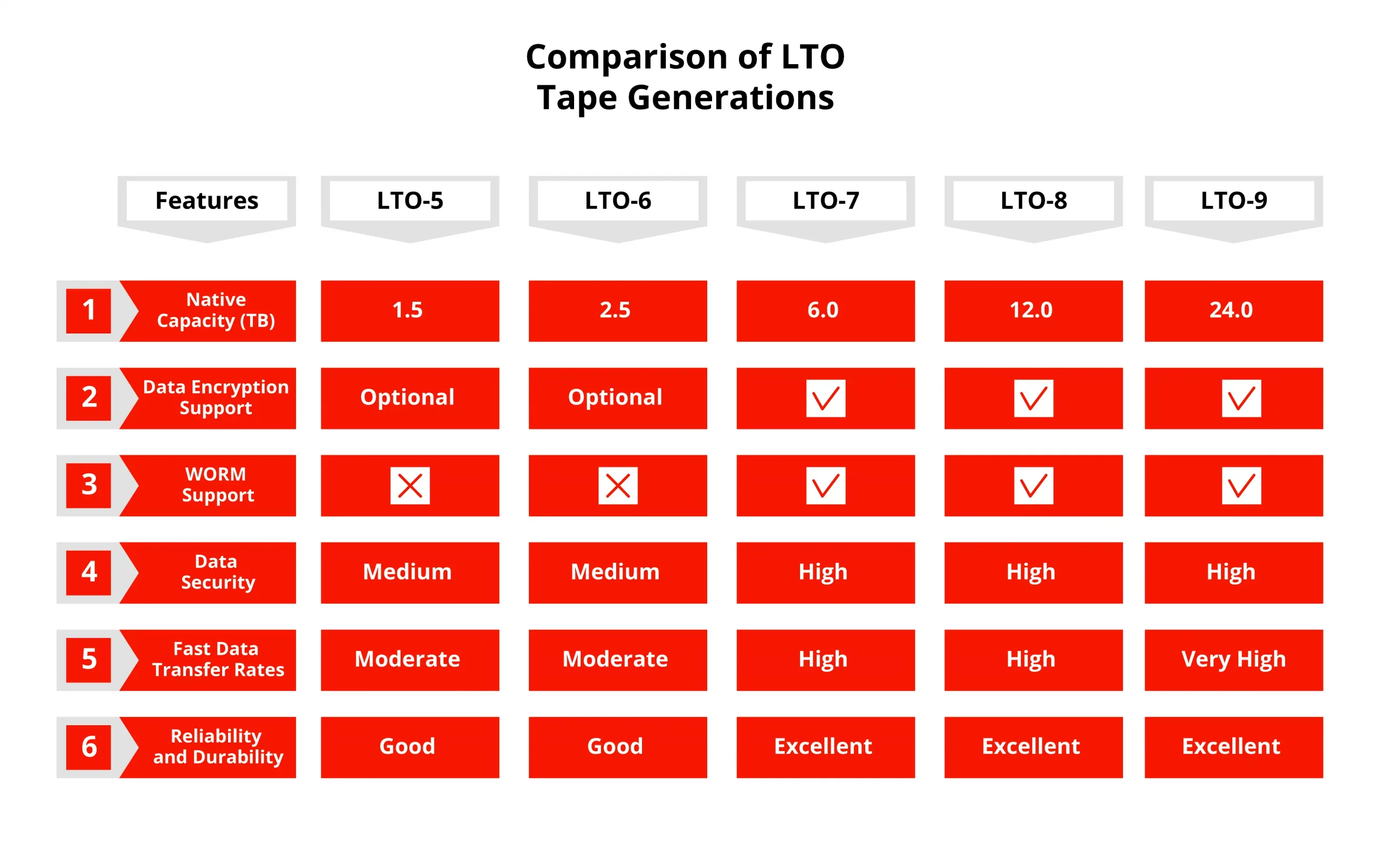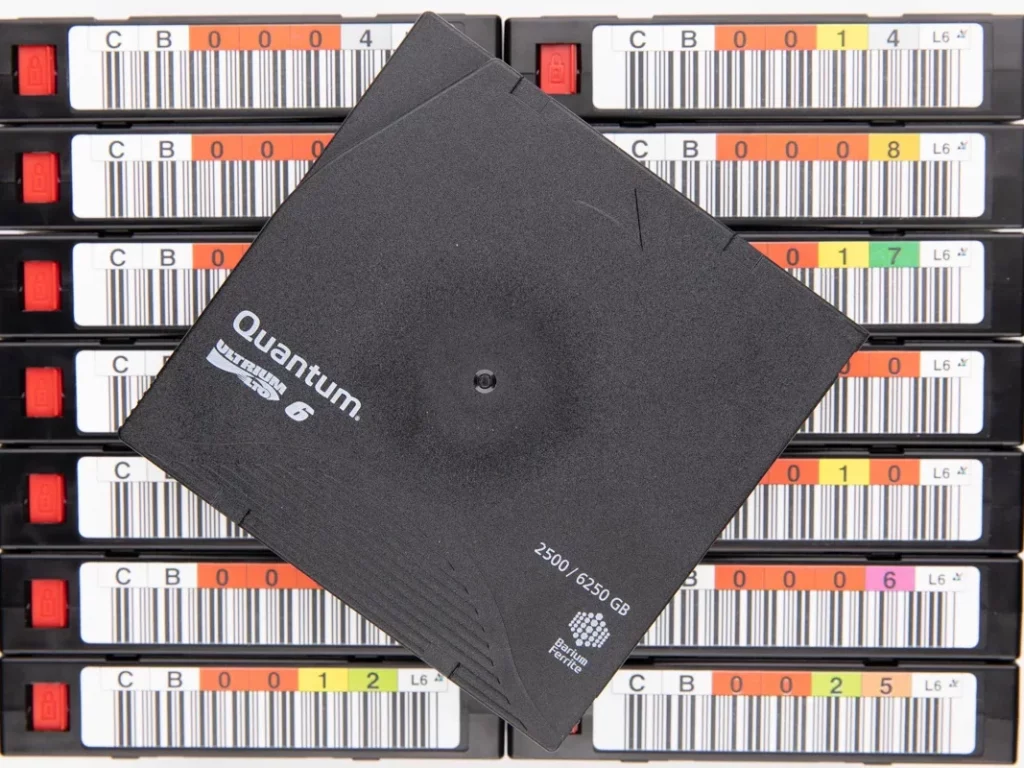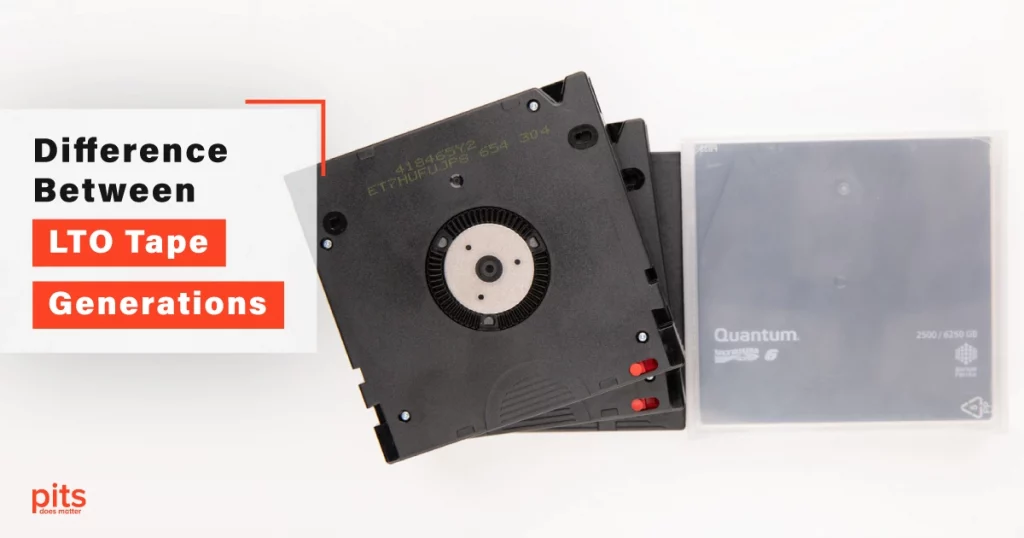Linear Tape-Open (LTO) technology is a magnetic tape storage technology that has been developed and enhanced over the years. LTO technology provides a cost-effective, reliable, and scalable solution for storage and long-term data archiving. The LTO Consortium, consisting of IBM, Hewlett-Packard, and Quantum, has been driving the development of the LTO tape format.
LTO tapes are available in different generations, each with its own features and specifications. In this blog, our team will examine the LTO tape generations, specifically LTO 5, LTO 6, LTO 7, LTO 8, and LTO 9.
LTO 5 Tape Drive
LTO 5 was introduced in 2010 and had a native storage capacity of 1.5 TB and a compressed capacity of 3.0 TB. The tape has a data transfer rate of 140 MB/s native and 280 MB/s compressed. LTO 5 tapes also feature partitioning, allowing for enhanced file control and faster access. Additionally, LTO 5 tapes are backward compatible with LTO 4 tapes.
LTO 6 Tape Drive
LTO 6 was introduced in 2012 and had a native capacity of 2.5 TB and a compressed capacity of 6.25 TB. The tape has a data transfer rate of 160 MB/s native and 400 MB/s compressed. LTO 6 tapes also feature partitioning, allowing for enhanced file control and faster access. LTO 6 tapes are backward compatible with LTO 5 tapes.

LTO 7 Tape Drive
LTO 7 was introduced in 2015 and had a native capacity of 6.0 TB and a compressed capacity of 15.0 TB. The tape has a data transfer rate of 300 MB/s native and 750 MB/s compressed. LTO-7 tape drive also features partitioning, allowing for enhanced file control and faster access.
Additionally, LTO 7 has a new write head design that allows for higher recording density and improved read/write performance. LTO 7 tapes are backward compatible with tapes of previous generations.
LTO 8 Tape Drive
LTO 8 was introduced in 2017 and had a native capacity of 12.0 TB and a compressed capacity of 30.0 TB. The tape has a data transfer rate of 360 MB/s native and 900 MB/s compressed. LTO 8 generation also features partitioning, allowing for enhanced file control and faster access.
In addition, LTO 8 tapes have a new write head design that allows for higher recording density and improved read/write performance. LTO-8 tapes are backward compatible with LTO-7 tapes.
LTO 9 Tape Drive
LTO 9 was introduced in 2020 and had a native capacity of 18.0 TB and a compressed capacity of 45.0 TB. The tape has a data transfer rate of 400 MB/s native and 1,000 MB/s compressed. LTO 9-generation tapes also feature partitioning, which allows for enhanced file control and faster file access.
Moreover, LTO-9 cartridge tapes have a new write head design that allows for higher recording density and improved read/write performance. LTO-9 tape drives are backward compatible with LTO-8 tapes.

LTO tape technology has been around for over 20 years and has evolved over the years to provide faster data transfer rates, larger capacities, and improved read/write performance. LTO tape technology provides a cost-effective, reliable, and scalable solution for data storage and archiving.
The different LTO tape generations offer a range of options for businesses and organizations to choose from based on their specific data storage and archiving needs.
Regardless of the many advantages of tape drives, data loss is still possible. In case of file inaccessibility situation, it is critical to entrust your case to a professional data recovery company.
High Success Rate for Tape Drives at PITS Global
PITS Global Data Recovery Services is a leading provider of data recovery solutions for businesses and individuals. We specialize in recovering data from LTO tapes of all generations, including LTO 5, LTO 6, LTO 7, LTO 8, and LTO 9.
Our team of experienced data recovery experts uses state-of-the-art tools and techniques to recover data from LTO tapes. We understand the importance of data to our clients, which is why we provide a reliable and efficient data recovery service.
Engineers at PITS begin the recovery process by evaluating the tape and diagnosing the problem. This process involves checking the tape for physical damage and analyzing the error messages displayed during the backup process.
In some cases, the LTO tape may be dirty or contaminated, leading to read/write errors. We use specialized equipment to clean and restore the tape to its original condition, allowing us to successfully restore inaccessible data.

If you’re facing a data loss situation, don’t hesitate to contact us. Our 24/7 data recovery services are available to you, 365 days a year. Let us help you recover your precious data today.

We start the recovery process with a risk-free evaluation. Our technicians estimate reasons for data loss and the level of damage. Based on it, we select the most suitable recovery strategy.

With years in the data recovery industry, our company supports the highest customer satisfaction rate. We do everything to provide a positive experience for our clients.

During our remote customer file verification session, you will thoroughly review all necessary documents and records to ensure accuracy and compliance.

We offer data recovery services from over 50 locations across the US. This means that no matter where you are located, you can access our services to recover the data.

With our certified data recovery services and 99% success rate, we are confident that we can recover your precious data and get you back up and running in no time.
Our team of data recovery experts can recover data from damaged or corrupted LTO tapes using specialized tools and techniques. We have the expertise to handle any type of data loss, including accidental deletion, formatting, malware, and physical damage to the tape.
Our company understands the importance of data confidentiality and security. Hence, we have strict policies and procedures to protect our client’s data. We maintain a secure facility, and all our employees undergo regular data security and confidentiality training. We ensure the highest level of data protection and deliver maximum results.
We provide a comprehensive range of data recovery solutions for businesses and individuals. We have the expertise and tools to recover data from LTO tapes of all generations. Contact us today to learn more about our LTO tape data recovery services. You can get in touch with us by filling in the form below.
Frequently Asked Questions
How long is an LTO-8 tape?
An LTO-8 tape typically has a 12 TB native capacity and up to 30 TB compressed capacity. Its dimensions are approximately 4.02 inches wide, 4.15 inches deep, and 0.85 inches tall. The length of the tape can vary but is usually around 960 meters (3,150 feet).
What is the difference between LTO-8 and LTO-9?
LTO-8 and LTO-9 differ primarily in terms of their storage capacity and data transfer speeds. LTO-9 typically offers a greater native capacity of approximately 18 to 20 TB, surpassing LTO-8’s 12 TB. Moreover, LTO-9 facilitates faster data transfer rates, enabling swift backup and data retrieval. Additionally, LTO-9 drives possess backward compatibility with LTO-8 tapes, ensuring smooth data migration.
What is an LTO-5 tape?
LTO-5 represents a stage in LTO tape technology characterized by a primary storage capacity of about 1.5 terabytes, which can be expanded up to 3.0 TB when compressed. This version marked a notable advancement from earlier LTO iterations, delivering enhanced capabilities for data storage and backup. LTO-5 tapes enjoy extensive use in the fields of archival storage and data backup.
What is an LTO-6 tape drive?
The LTO-6 tape drive is a storage device specifically created for reading and writing data on LTO-6 tapes. LTO-6, the sixth version of Linear Tape-Open technology, accompanies a native storage capacity of around 2.5 terabytes or up to 6.25 TB when compressed. These tape drives are extensively utilized for data backup and archival purposes owing to their speedy data transfer rates.
How big is an LTO-7 tape drive?
LTO-7 tape drives commonly come in a compact half-height design, with dimensions of about 5.25 inches (133 millimeters) wide, 8.8 inches (222 millimeters) deep, and 2.6 inches (66 millimeters) tall. This particular size is widely adopted among LTO tape drives, ensuring compatibility with different tape libraries and storage systems.
